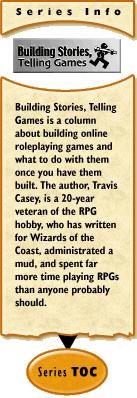 #14: Stranger Than Fiction
#14: Stranger Than Fiction
A while back, a good friend of mine starting reading my columns, and he immediately pointed out to me that I'd forgotten one of the best resources for inspiration in my column on ideas – history. Which is strange, considering that I love to read history books, and I've drawn ideas for many a game from them. So, I thought I'd take this chance to correct my error.
History is a wonderful source of ideas. I mentioned in the last column that historical beliefs about magic can be a good starting place for a magic system, and the same is true for many other aspects of a game world – cultures, situations, architectural styles, clothing, armor, etc.
Real-world history is, of course, of immediate interest to anyone creating a game in a historical or pseudo-historical setting. It's also of interest to those creating games in purely imaginary settings, though. It can be used for inspiration, and even most purely imaginary settings draw some elements from the real world – for example, most fantasy settings draw many elements from medieval Europe.
The traditional, school-taught "names and dates" type of history can be of some use, but there are other types of history books that are even more useful. The first type is "this is how people lived" books, such as Gies & Gies Life in a Medieval Castle, Life in a Medieval City, etc. This type is very useful for inspiration in writing descriptions, character histories, and other such things. Many such books will also talk about things like how holidays were celebrated, marriages conducted, and other such background that can be wonderful for giving texture to a world.
The second type that I've found to be useful are encyclopedia-like history books, presenting a wide range of short articles or entries on a particular historical society or era. One of my favorites in this area is Adkins and Adkins' Handbook to Life in Ancient Rome. This book presents a wide variety of short articles, covering such things as the organization of the Roman army, Roman religion, arms and armor, plumbing, money, holidays, and all sorts of other such useful things. The book is part of a series, which also has Handbook to Life in Ancient Egypt (by A. Rosalie David) and Handbook to Life in Ancient Greece (by Adkins and Adkins). This sort makes a wonderful complement to books of the first sort, which usually don't go into much depth on any given aspect of "how things worked".
A third type is books that attempt to analyze history. One of my favorites in this category is Jared Diamond's Guns, Germs, and Steel, in which the author speculates on why it was that Europeans were able to take over the Americas, the Pacific islands, and so many other civilizations the way they did. I'm currently reading William H. McNeill's Plagues and Peoples, which has research and speculation on the impact that diseases have had on history. This sort of book I've found to be useful when creating new game worlds (or universes, for SF games), to give a framework on which to hang the world's history, or at least parts of it.
In looking for history books, one shouldn't overlook children's books. While these often give a simplified view of history, and are also prone to including things that "everyone knows" that simply aren't true, they do have one saving grace – namely, artwork and pictures. History books meant for adults are often very short on artwork, and most don't have any color art or picutres. Those that do are often very expensive. Children's books, however, are generally loaded with pictures, often in full color, and are usually fairly cheap. Thus, they can make excellent "visual references" for help in describing things or in creating artwork for games.
Clip-art books can also be a useful source of artwork, with the added bonus that the art is often freely reproducible – so you can scan it and use it in your game, on your web site, or wherever.
A few things to watch out for: First, I try to avoid older history books when I can – say, from the 1950s and before. There's been a lot of new discoveries and re-analyzing of old knowledge in the last fifty years or so. I prefer to read more up-to-date books because of that. Secondly, when using history as a basis for things, be careful not to simply lift a historical culture or other thing out of its real historical setting and simply plop it into a new setting without thinking about how it fits into that setting, what cultural changes might be necessary, etc. I've said it before, and I'll say it again – the unexamined setting is not worth playing in. Know why you're putting these things into your setting, and examine how the pieces you're putting together are going to fit in.
I've also mentioned before that it's easy to fall into clichés when using historical cultures. The same is true of other historical elements. Thinking about how these things fit into your world will help in avoiding clichés, as can carefully modifying them or combining them with other elements.
Well, that's all for this time... hope to see you in the forums!



